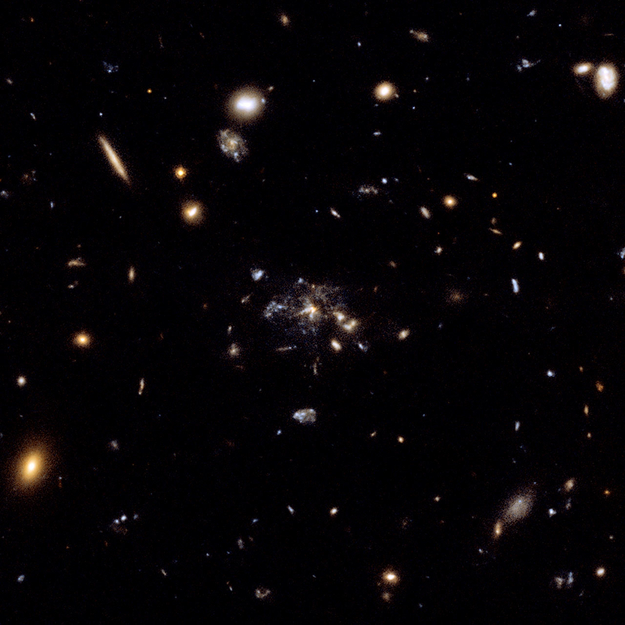
Astronomers using the Atacama Large Millimeter/submillimeter Array (ALMA) to peer at the distant, very massive Spiderweb Galaxy expected to find droplets of condensed water in the galaxy’s central, dusty, star-forming regions. Instead, they found that the water is located in the galaxy’s outskirts. This result might provide clues to the processes that trigger star formation in some galaxies; in the case of the Spiderweb, known radio jets might play a role. Astronomer Bitten Gullberg presented these results yesterday (July 1, 2016) at the National Astronomy Meeting 2016 in Nottingham, England. She said:
The results are quite unexpected in that we’ve found that the water is located nowhere near the dusty stellar nurseries.
Observations of light emitted by water and by dust often go hand-in-hand. We usually interpret them as an insight into star-forming regions, with the illumination from young stars warming dust particles and water molecules until they start to glow.
Now … for the first time, we can separate out the emissions from the dust and water populations, and pinpoint their exact origins in the galaxy.
The new observations are made possible by the ALMA telescope in northern Chile, whose website describes it as “a single telescope of revolutionary design,” composed of 66 high-precision antennas. The telescope is located on the Chajnantor plateau, more than 16,000 feet (5,000 meters) above sea level.

The astronomers’ statement said:
The Spiderweb Galaxy is one of the most massive galaxies known. It lies 10 billion light-years away and is made up of dozens of star-forming galaxies in the process of merging together. The ALMA observations show that the light from the dust originates in the Spiderweb Galaxy itself. However, the light from the water is concentrated in two regions far to the east and west of the galaxy core.
Gullberg and her colleagues believe that the explanation lies with powerful jets of radio waves that are ejected from a supermassive black hole at the center of the Spiderweb Galaxy. The radio jets compress clouds of gas along their path and heat up water molecules contained within the clouds until they emit radiation.
Gullberg added:
Our results show how important it is to pinpoint the exact locations and origins for light in galaxies. We may also have new clues to the processes that trigger star formation in interstellar clouds.
Stars are born out of cold, dense molecular gas. The regions in the Spiderweb where we’ve detected water are currently too hot for stars to form. But the interaction with the radio jets changes the composition of the gas clouds. When the molecules have cooled down again, it will be possible for the seeds of new stars to form.
These ‘dew drop’ regions could become the next stellar nurseries in this massive, complex galaxy.

Bottom line: Astronomers using ALMA to study the Spiderweb Galaxy, aka MRC 1138-262, unexpectedly found water droplets at the galaxy’s outskirts.











